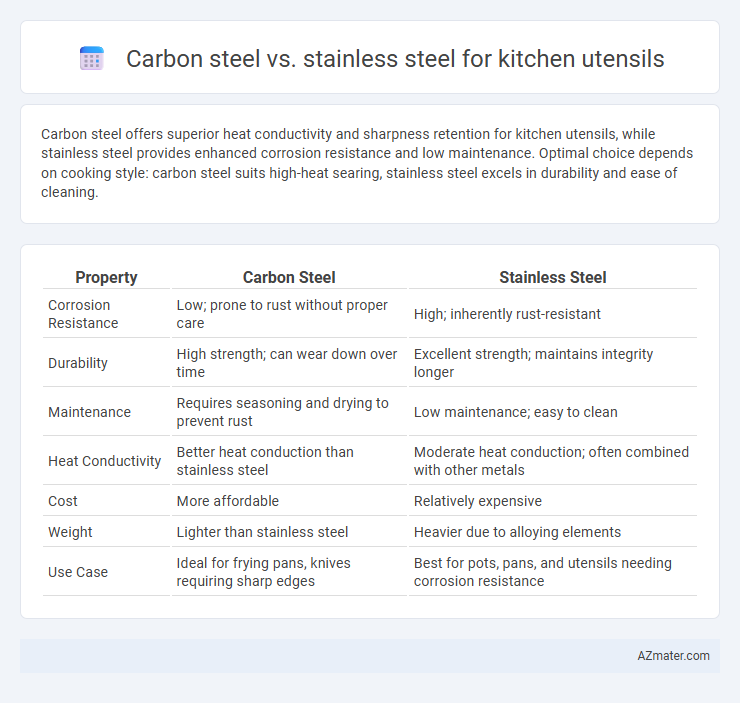Carbon steel offers superior heat conductivity and sharpness retention for kitchen utensils, while stainless steel provides enhanced corrosion resistance and low maintenance. Optimal choice depends on cooking style: carbon steel suits high-heat searing, stainless steel excels in durability and ease of cleaning.
Table of Comparison
| Property | Carbon Steel | Stainless Steel |
|---|---|---|
| Corrosion Resistance | Low; prone to rust without proper care | High; inherently rust-resistant |
| Durability | High strength; can wear down over time | Excellent strength; maintains integrity longer |
| Maintenance | Requires seasoning and drying to prevent rust | Low maintenance; easy to clean |
| Heat Conductivity | Better heat conduction than stainless steel | Moderate heat conduction; often combined with other metals |
| Cost | More affordable | Relatively expensive |
| Weight | Lighter than stainless steel | Heavier due to alloying elements |
| Use Case | Ideal for frying pans, knives requiring sharp edges | Best for pots, pans, and utensils needing corrosion resistance |
Introduction: Understanding Steel Types in Kitchen Utensils
Carbon steel offers excellent heat conductivity and sharpness for kitchen knives, making it favored by professional chefs, while stainless steel provides superior corrosion resistance and easy maintenance, ideal for everyday cookware. The unique composition of carbon steel includes higher carbon content, enhancing hardness but requiring careful seasoning to prevent rusting. Stainless steel alloys contain chromium, which forms a protective oxide layer, ensuring durability and a sleek appearance suitable for various kitchen utensils.
Composition Differences: Carbon Steel vs Stainless Steel
Carbon steel for kitchen utensils primarily contains iron with 0.05% to 2.0% carbon, providing excellent heat retention and a sharp edge but is prone to rusting without proper care. Stainless steel incorporates a minimum of 10.5% chromium, which forms a protective oxide layer that enhances corrosion resistance and requires less maintenance. The presence of alloying elements like nickel and molybdenum in stainless steel improves durability and resistance to staining, making it ideal for long-term kitchen use.
Durability and Longevity
Carbon steel kitchen utensils offer superior durability due to their high carbon content, making them resistant to wear and deformation under heavy use. Stainless steel, while slightly less hard, provides excellent longevity through its corrosion-resistant properties, preventing rust and maintaining structural integrity over time. Both materials excel in durability, but carbon steel demands more maintenance to prevent rust, whereas stainless steel ensures long-lasting hygiene and low upkeep.
Resistance to Rust and Corrosion
Carbon steel offers excellent heat conduction but requires regular seasoning to prevent rust due to its high iron content, making it more prone to corrosion when exposed to moisture and acidic foods. Stainless steel contains chromium, typically 10.5% or higher, which forms a protective oxide layer that resists rust and corrosion, ensuring durability and minimal maintenance in kitchen environments. For long-term resistance to corrosion and ease of care, stainless steel is the preferred choice for kitchen utensils.
Heat Conductivity and Performance
Carbon steel offers excellent heat conductivity, allowing for rapid and even heating, which enhances cooking performance by preventing hot spots. Stainless steel, while less conductive, provides superior corrosion resistance and durability, making it ideal for long-term kitchen use. For tasks requiring quick temperature changes and precision, carbon steel outperforms stainless steel in heat responsiveness and cooking efficiency.
Maintenance and Care Requirements
Carbon steel kitchen utensils require regular seasoning to maintain their non-stick surface and prevent rust, needing thorough drying after each use to avoid corrosion. Stainless steel utensils are highly resistant to rust and corrosion, demanding less frequent maintenance and allowing easy cleaning with standard dish detergents. Both materials benefit from avoiding prolonged exposure to acidic foods to preserve their surface integrity and longevity.
Weight, Balance, and Handling
Carbon steel kitchen utensils offer a lighter weight compared to stainless steel, enhancing ease of handling during extended cooking sessions. Their superior balance, due to a higher strength-to-weight ratio, provides chefs with precise control and responsiveness. Stainless steel utensils, while heavier and often less balanced, excel in durability and corrosion resistance but may sacrifice some handling comfort and agility.
Cost Comparison: Carbon Steel vs Stainless Steel
Carbon steel kitchen utensils generally cost less than stainless steel due to lower raw material and manufacturing expenses. While carbon steel offers affordability, stainless steel tends to have higher upfront costs but provides superior corrosion resistance and durability. Choosing between the two often depends on budget constraints and the desired longevity of the kitchen tools.
Best Uses for Each Steel Type in the Kitchen
Carbon steel excels in kitchen utensils requiring superior heat conductivity and sharp edges, making it ideal for high-performance knives, woks, and frying pans that benefit from rapid heat changes and precise cutting. Stainless steel offers excellent corrosion resistance and low maintenance, perfect for everyday cookware, mixing bowls, and utensils exposed to moisture and acidic foods. Each steel type enhances kitchen functionality by balancing durability, heat retention, and ease of cleaning in targeted cooking applications.
Conclusion: Choosing the Right Steel for Your Cooking Needs
Carbon steel offers superior heat conductivity and sharpness retention, making it ideal for chefs requiring precision and quick temperature changes. Stainless steel provides excellent corrosion resistance and low maintenance, perfect for users prioritizing durability and ease of cleaning. Selecting between carbon steel and stainless steel depends on balancing performance needs with convenience and long-term care preferences in the kitchen.

Infographic: Carbon steel vs Stainless steel for Kitchen utensil
 azmater.com
azmater.com